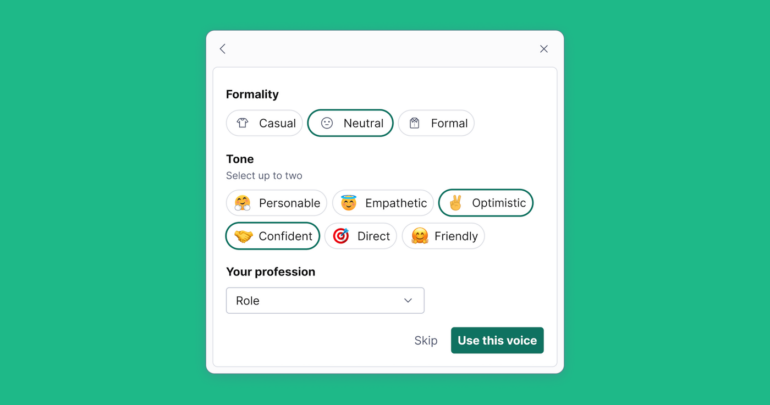A natural language AI writing assistant is the latest in Grammarly’s attempts to assist with professional writing.
Generative artificial intelligence has been steadily moving into the mainstream. Media companies now need to keep an eye out for AI-generated submissions or AI-facilitated plagiarism. The latest public adopter of AI is Grammarly, which provides spelling and grammatical corrections and suggested wording for blog posts and other content.
SEE: Find out how to streamline business operations with this AI e-book package (TechRepublic Academy)
The new product, called GrammarlyGo, was announced on Thursday and will be available to some users in beta in April. Specifically, this applies to:
- Users of Grammarly’s free plan in the U.S., Canada, the U.K., Australia, New Zealand, Germany, Poland and Ukraine.
- Subscribers to Grammarly Premium, Grammarly Business and Grammarly for Education.
- Developers using the Grammarly Text Editor SDK.
Jump to:
What is GrammarlyGo?
GrammarlyGo’s AI is a mixture of OpenAI’s GPT-3 and proprietary AI and machine learning models. Grammarly hasn’t decided on a final launch partner for its service, Grammarly public relations manager Sheridan Smalley said in an email interview with TechRepublic.
“As we continue to find new ways to deepen the value we deliver to our customers, we will continue to experiment with the latest LLM (logic learning machine) advancements and technologies, including those we build internally,” Smalley said.
The text and chat AI platform GPT-3 has become a household name due to media coverage, word of mouth and partnerships with Google.
While generative artificial intelligence can create comprehensible prose based on a prompt, natural language AI is designed to hold a real-time conversation with a person as if they were talking to another human. GrammarlyGo is the former.
GrammarlyGo demos writing corporate reports and emails
Grammarly has been applying its in-house AI to written content all along with its grammar suggestions. The big change is that, with generative AI, users can input prompts such as “give me an outline for a project brief’” in order to get an output of ostensibly original text. Grammarly uses job descriptions and the project brief example to show this off and claims that it can help workers “save time, enhance their creativity and get more done.”
Along with taking prompts, GrammarlyGo asks users to choose the desired “formality,” tone” and “profession.” From there, it spits out the natural language-type response. After the AI takes its first try, the user can further “improve,” “shorten,” or “simplify” the content. Tones range from “direct” to “empathetic.”

In addition, GrammarlyGo is designed to assist with writing emails and long-form documents. Many of the examples show communication between people in the same organization, but there’s nothing stopping in-house writers from also using GrammarlyGo to draft public-facing blog posts or marketing material.
The AI requires a human in the loop to edit the information to make sure it’s accurate. For a manager deciding to allow or instruct employees to use this Grammarly feature, it may be a question of balancing short-term efficiency with possible long-term errors.
Search results written by ChatGPT are filled with factual errors since the AI focuses on putting words together in a coherent, natural-sounding order, not on fact-checking those words. So, for example, a potential employee could come into a job interview with incorrect ideas about a role if the AI is incorporated early in the hiring process and no humans check it for accuracy.
Grammarly positions GrammarlyGo as an attempt to capture an end-to-end experience that could widen its hold over content creation work, aiming to go “beyond the editing stage to support our users across the entire communication life cycle, including conception and composition.”
Businesses should consider putting policies in place for the use of AI like this that covers details such as: Who should use it? When? How much human oversight does it require?
SEE: Artificial Intelligence Ethics Policy (TechRepublic Premium)
Ethical policies may also be useful, both in terms of what AI is allowed to say and how much human oversight it receives. Some organizations might want to put into writing who is liable for possible harm from AI-generated text and how harm might be handled.
How Grammarly addresses security and compliance concerns
Grammarly emphasized that its product is private and does not record keystrokes or sell data. Some fields, such as birthdays and payment information, block Grammarly from seeing them. On the security side, Grammarly stays up to date with GDPR, HIPAA, CCPA and other geographically-based security requirements.
The company noted that GrammarlyGo is switched off in the default dashboard, and it will not be available to K-12 schools with Grammarly partnerships, so don’t expect essays written by AI from pre-college students — at least not from this particular service.
SEE: ChatGPT powers up Salesforce’s Einstein AI (TechRepublic)





